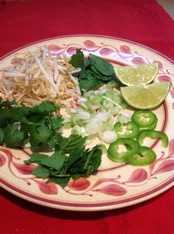|
|
 |

Apr 30, 2013
Wine With…Faux Pho
If you read some of the online comments about Pho, you’ll find that partisans of this Vietnamese noodle soup take its preparation very seriously. Add one “wrong” ingredient or slice the meat too thick -- and watch the virtual howl erupt! This is one reason we’re referring to our abbreviated version as an adaptation rather than a version of classic pho. We aren’t suggesting that our quick-and-easy variation approaches the depth of flavor and complex nuances of the traditional soup, but for those days when there’s no time to simmer bones for hours, or when you’re hankering for a delicious, soul-satisfying meal sooner rather than later, we find that faux pho is better than no pho. approaches the depth of flavor and complex nuances of the traditional soup, but for those days when there’s no time to simmer bones for hours, or when you’re hankering for a delicious, soul-satisfying meal sooner rather than later, we find that faux pho is better than no pho.
Faux Pho
(serves 4-6)
The broth is what makes our pho inauthentic. The star ingredient in classic beef pho (pho bo) is a broth made from long-simmered bones (shoulder, knuckle, shank, or marrow). Alternatively, some supermarkets today sell prepared beef pho stock, but we’ve found that commercial or homemade chicken stock is a viable substitute. (In our experience, prepared beef stock tends to be too sweet and heavy on the palate for a brightly flavored dish such as this.) Onion, ginger and other spices are typically charred before being added to the beef essence, but this was another step we skipped. And by the way, the correct pronunciation of pho is “fuh”.
Freezing the steak for an hour or so makes it easier to cut the necessary ultra thin slices (they must be paper-thin in order to cook when the hot broth is poured over them).
Be sure to have all ingredients ready to assemble when the soup is dished up at the last minute.
5 cups chicken broth
4 garlic cloves, peeled and smashed
2-3 cinnamon sticks, about 3 inches long
2 star anise
1 tablespoon soy sauce
1 tablespoon Asian fish sauce
about 1/3 cup each fresh whole leaves of basil, mint and cilantro
about 2 cups bean sprouts
12-16 ounces steak such as sirloin
1 pound dried wide rice noodles
lime wedges
Put the chicken broth, garlic, cinnamon, star anise, soy sauce and fish sauce in a large pot and bring to a boil. Simmer, covered, for about 15 minutes, then remove the solid ingredients with a slotted spoon and discard (the broth may be made ahead of time).
To serve, bring the broth back to a boil. Tear the basil and mint leaves in half (or quarters if they are large), and tear the cilantro into smaller pieces. Slice the steak as thinly as possible. Bring a large pot of salted water to a boil and cook the noodles until done (5-8 minutes). Drain and divide the noodles among 4 to 6 serving bowls. Top each with herbs, bean sprouts and sliced meat. Pour or ladle hot broth over the other ingredients, poking the meat under the hot liquid if necessary to make sure it cooks. Squeeze lime over each filled bowl, and serve immediately, garnished with extra lime wedges.
* * *
The first time we made our faux pho we were convinced beforehand that the relatively light ingredients (chicken stock, fresh green aromatics, bean sprouts) would result in a dish better suited to white wine than red, but this did not prove to be the case. As it turned out, one of the many charms of this recipe is that the soup is adaptable to a much wider range of wines, including reds, whites, even bubblies, than we’d expected. The only two types of wines that did not work with it were delicate, lacy whites and full-fleshed, tannic reds. Pretty much everything else we tried, and we sampled thirteen different wines, paired just fine with our pho.
Selection
|
Approx. Price
|
Comments
|
Caparzo, Tuscany (Italy) Sangiovese Toscana 2011
(Imported by Vineyard Brands)
|
$14
|
A dry, dusty note supports the bright cherry fruit in this light-bodied red, giving the wine both substance and subtlety. That savory element, reminiscent of dried spice, proved a great complement to the equally spice-laden pho.
|
Carmel Road, Arroyo Seco, Monterey (California) Pinot Noir 2011)
|
$22
|
Bright and juicy, with red fruit flavors and even a hint of something resembling cola in the finish, this succulent red enlivened the dish, bringing out its fresh character and almost muting its earthy side.
|
Marqués de Cáceres, Rioja (Spain) Reserva 2008
(Imported by Vineyard Brands)
|
$25
|
This Rioja worked just as well as the Pinot Noir we are recommending, but to the opposite effect. Instead of brightening the flavors in the dish, it deepened them, giving the pho added substance and depth. Which wine to choose is ultimately a matter of personal preference, and we very much enjoyed trying both.
|
Parducci, Mendocino (California) Pinot Gris “Small Lot Blend” 2010
|
$11
|
A full-flavored, rich but not at all heavy or oak-dominated white, this Pinot Gris tastes of apples and pears, with a hint of sweet spice. It worked beautifully with the pho, enhancing especially the earthy flavors coming from the sprouts and herbs.
|
Scharffenberger, Mendocino County (California) Brut NV
|
$20
|
Always a good value in high-class California bubbly, this sparkler made for an excellent match. Its bright citrus fruit, augmented by a toasty, yeasty undertone, gave the pho added subtlety and sophistication.
|
|
 |
|